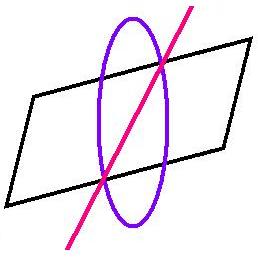1. Similar and congruent triangles
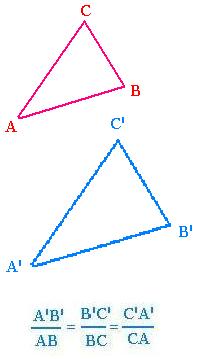
Two objects are similar if they both have the same shape.
Two triangles &eElta;ABC and ΔA'B'C'are similar (ΔABC &simi; ΔA'B'C') if
the following proportionality is satisfied:
A'B'/AB = B'C'/BC = C'A'/CA
They are congruent (ΔABC ≅ ΔA'B'C') if they are similar and have the same size.
The above ratio is then equal to 1.
There are two rules for similar triangles:
1. The AA (Angle-Angle) rule:
If two angles of a triangle are equal to two angles of another
triangle, then the triangles are similar ( in a triangle, if
two angles are known, the third is obviously as the supplement).
If the angles are equals:
∠A = ∠A',
∠B = ∠B',
and ∠C = ∠C'.
According to the sine law, we write:
For the ΔABC:
AB/sin C = BC/sin A = AC/sin B, that gives:
sin A/sin C = BC/AB (I.1)
sin B/sin A = AC/BC (I.2)
sin B/sin C = AC/AB (I.3)
For the ΔA'B'C':
A'B'/sin C' = B'C'/sin A' = A'C'/sin B'=
A'B'/sin C = B'C'/sin A = A'C'/sin B; that gives:
sin A/sin C = B'C'/A'B' (II.1)
sin B/sin A = A'C'/B'C' (II.2)
sin B/sin C = A'C'/A'B' (II.3)
The two group relationships (I) and (II) gives:
BC/AB = B'C'/A'B'
AC/BC = A'C'/B'C'
AC/AB = A'C'/A'B'
Then:
A'B'/AB = B'C'/BC = A'C/AC, that is the ΔABC and
the ΔA'B'C' are similar.
 2. SAS (Side Angle Side) rule:
2. SAS (Side Angle Side) rule:
If two sides of a trinagle, including an angle, are proportional to those
of another trinagle including an angle equal to the first; then these two
triangles are similar.
Let the angle ∠A = ∠A', and the
sides AC = m A'C' and AB = m A'B'
( m is the related coefficient of proportionality). According to the Cosine Law, we write:
For the ΔABC:
BC2 = AC2 + AB2 - AC . AB cos A, that is:
For the ΔA'B'C':
B'C'2 = A'C'2 + A'B'2 - A'C' . A'B' cos A', that is:
B'C'2 = m2 AC2 + m2 AB2 - m2 AC . AB cos A
which is equal to m2 BC2
Then B'C' = m BC
The three sizes are then proportional:
m = B'C'/BC = A'B'/AB = A'C'/AC
The triangles ΔABC and ΔA'B'C' are similar.
To recap:
SSS (proportionality) → similar triangles
AA (or AAA) → similar triangles
SAS → similar triangles
2. Applications
2.1. Tangent and secant
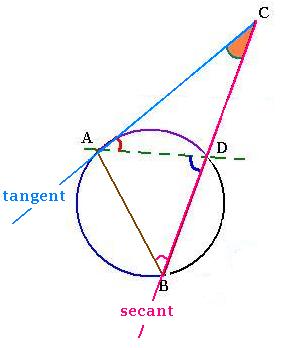
The angle ∠CAD = arc AD/2, so the angle ∠B is. Then
∠ CAD = ∠ABC. The angle ∠C is common.
We have then the case of AA or AAA rule, furthermore the triangles ΔABC and ΔADC
are similar.
Then:
BC/AC = AC/CD = AB/AD. Thus:
AC2 = CD . CB
CA2 = CD . CB
2.2. Relationships in the rectangular triangle
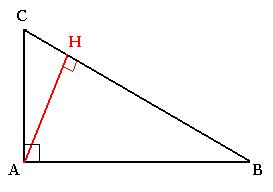
Let's draw a rectangular triangle CAB, where the angle A
is right.The point H is the projection of the point A on
the the side BC. The angle AHC and the angke AHB are right.
For the triangles CAB and AHB, the angle B is common. Then
the angles BAH and ACH are equal: BAH = ACH. The
triangles AHB and CAB are then similar. Thus:
BC/AB = AC/AH = AB/BH (1)
Similarly, the angle C is common, the angles CAH and
ABC are equal: CAH = ABC. The triangles CHA and CAB
are then similar. Thus:
BC/AC = AC/CH = AB/AH (2)
The triangles CHA, AHB and CAB are then similar. Using the
similarity of the triangles CHA and AHB, we can write:
AB/AC = AH/CH = HB/AH (3).
The relationships (1), (2) and (3) give successively:
AB2 = BH . BC
AC2 = BC . HC
AH2 = BH . CH
2.3. Congruent angles
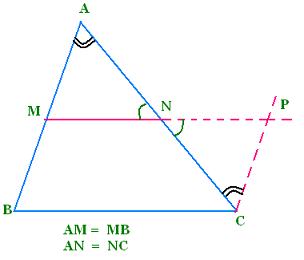
In the triangle ABC, we join the middle point M of the
size AB to the middle point N of the size CA. We want
to prove that MN is parallel to BC and equal to its
half.
Hypothesis: MA = MB and NA = NC
Conclusion: MN//BC and MN = BC/2
Let's extend MN to MP and draw the parallel CP to
the side AB. The side AC as a secant gives:
Angle CAB = angle ACP (as alternate interior angles).
The two angles ∠CNP and ∠MNA are vertical and then
congruent. Then ∠CPN = ∠AMN. Furthermore
the triangles ΔAMN and ΔCNP are similar. More, they are
congruent (the ratio AN/NC = 1).
The angles CNP and MNA are congruent, then PC = AM = MB (
by hypothesis), then MB = CP and ABCP is a parallelogram
( because if CP // MB and CP = BM, then the quadrilateral
MBCP is a parallelogram), then MN//BC.
MBCP is a parallelogram, then MP = BC. Since NP = MN, then the
point N is the middle of MP, and MP = 2 MN
2MN = MP = BC, then MN = BC/2
conclusion:
MN // BC and MN = BC/2
© The Scientific Sentence. 2007.
axiom
theorem
postulate
Lemma
corollary
© The Scientific Sentence. 2007.
| |
|
